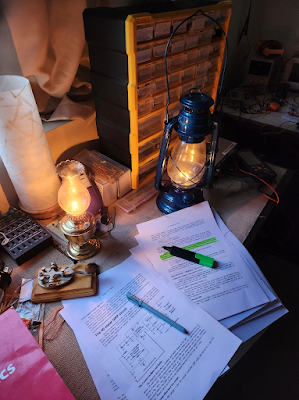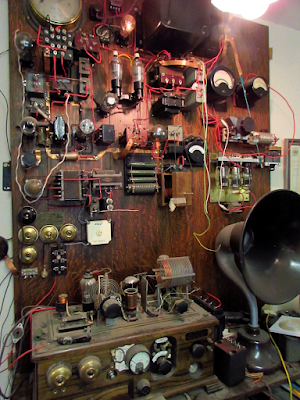Serving the worldwide community of radio-electronic homebrewers. Providing blog support to the SolderSmoke podcast: http://soldersmoke.com
Podcasting since 2005! Listen to Latest SolderSmoke
Friday, October 17, 2025
"Keep Calm and Solder On"
Thursday, October 9, 2025
Why I can listen to both sides of VK-G Long Path QSOs in the Dominican Republic
Bottom line: I think when Australians talk to Brits via long path, in the Dominican Republic I am between the two. Both have their beam antennas aimed (generally) un my directions. With an omnidirectional antenna (my 1/4 wave vertical) I can hear them both. While they are on the Long Path to each other, I am Short Path to both of them.
Here is my log entry (From the Dominican Republic):
August 20, 2025
20S around 0830 UTC VK5UK Rich and G2YT Peter. Rich was in LP contact with Peter My VFO was moving as the air conditioner kicked in. I think I was hearing both of them SP. With VK5UK I was off the side of his beam. Same with Peter G2YT.
----------------------------
Peter G2YT wrote:
Yes, Rich and I were working Long Path… I was beaming at the top end of South America (about 240 degrees) and Rich was beaming approx 120 degrees.
------------------------------
Rich, VK5UK wrote:
Hi, thanks for the email... My beam heading was around 150 degrees from VK long path to Europe you would have been receiving me via the shortest path between us, and I suspect you were being received by Peter on the same path? 73 Rich
------------------------------
Here is a good website that describes (using Australia to Europe) the Long Path and Short Path propagation paths:
https://www.pa9x.com/long-path-or-short-path-propagation/
Here is a link to Google's new AI (on this subject)
Friday, August 29, 2025
Shane G0JNR's FB SolderSmoke Direct Conversion Receiver -- With a Glow-In-The-Dark PTO Coil Form
Shane writes:
Shane G0JNR here. I've just got my Soldersmoke DC rx up and running! The thing that put me off earlier in the year was the 3d printed coil former. But my son has now got one and printer and printed one for me - as an added bonus, it glows in the dark! It didn't work straight away but perseverance has paid off. 73
Thanks Shane! Congratulations and Welcome to the Hall of Fame.
Tuesday, July 29, 2025
The Guy with the USB-powered X-Ray Machine -- The Identity of the Project 326 Builder
This morning a comment came in from Hong Kong/Shenzhen that explained who Project 326 is and why he was saying "tubes" and not "valves":
--------------------
Thank you for featuring my video. Some background for you, I am a British engineer and have lived in China for over 20 years. I am resident in both Hong Kong and Mainland China (Shenzhen, which is just over the border from Hong Kong). I used the term vacuum tubes as most of the viewers are from the US and us Brits are fully conversant with both terms, but in the US, they are often less 'bilingual' in these kinds of phrases.
Hope that helps!Friday, July 18, 2025
Friday, June 13, 2025
Britain's Secret Listeners
Today Hack-A-Day has an unsually good report on Britain's Voluntary Interceptors. I was especially touched by the story of the guy who provided reports while still bedridden from devastating wounds received in World War I.
https://hackaday.com/2025/06/12/crowdsourcing-sigint-ham-radio-at-war/#more-786810
I've had the video on the SolderSmoke blog several times. It is so good that it warrants inclusion yet again:
https://www.youtube.com/watch?v=RwbzV2Jx5Qo&t=228s
That regen looks a lot like the one I bought at the Kempton Park rally (London) so long ago. I still have it. And those headphones found in the old "radar" station look a lot like some that I have in my shack today. And of course there is that HRO dial. I build a whole receiver around that gem from Armand WA1UQO.
I thought the comments on the ability to detect the nationality of the enemy operator from his Morse Code "fist" (sending style) was very interesting.
Three cheers for the Voluntary Interceptors!
Friday, May 30, 2025
Hiss, Filters, QRM, and Hearing Loss: Do we need AF filters in direct conversion receivers?
Messages on Discord about the need to knock down higher frequency audio response in the SolderSmoke direct conversion receiver got me thinking.
I agree with Rick Campbell and others on the benefits of hearing a "wide open" direct conversion receiver. But Rick and others have built DC receivers with 3 kHz low pass AF filters. This made me ask myself a question: Is an audio filter in a direct conversion receiver a good idea?
And I started wondering if perhaps I was being too dismissive about the complaints about high frequency audio -- I had been attributing them to newcomers who were just unaccostomed to radio noise or "static." But maybe there was more to it than that. Maybe a big part of the problem was in my head, specifically in my ears. So this morning I did an experiment. I took an online hearing test. First, without my hearing aids: As expected, it showed significant high frequency loss. (It was as if the US Army had installed a 3 kHz audio low pass filter in my head!) Then I put my hearing aids in and retook the test: This time I passed the test and showed no loss. I then listened to the DC receiver with my hearing aids in. Now I could hear what builders on the Discord server were commenting on: I could hear higher frequency hiss, and, more importantly, stations that were producing 4-5 kHz sounds on my speaker were audible and annoying.
So I went back to Wes Hayward's November 1968 QST article. In his receiver, he has a low pass AF filter using an 88 MILLIHenry coil and a couple of capacitors to ground. I had a few of the coils (given to me years ago by a NOVA QRP club member) so I built it. With my hearing aids in, I noticed an immediate improvement. I then did what one of the Discord builders did and put the filter in with a switch that would let me make "with and without" comparisons. The filter definitely cuts down on any AF above about 3.5 kHz. And it doesn't seem to do damage to the desired signal. This is useful. I left the W7EL diplexer in the circuit.
This filter won't solve the image or "opposite sideband" problem inherent to simple DC receivers, but it will help with signals or noise that are producing tones above about 3.5 kHz in the receiver. I think this is especially important in countries in which there is a lot of SSB crowding on 40 meters. The UK, for example, has an allocation from 7.0 to 7.2 MHz. In the US we go from 7.0 to 7.3 MHz. That is a big difference.
So the answer is probably yes, an AF filter in a direct conversion receiver is probably a good idea, especially if you can switch the filter out of the receiver. You can live without these filters. Not having the filter keeps the receiver very simple, and lets it sound really great. But having the filter in there does help reduce interference and high frequency hiss. So I think this is a useful add-on mod for builders who see a need to cut down on the kind of interference that a lack of this filter causes.
In 2019 W7ZOI noted: "Another unusual element is the 88 mH toroid used in the audio low pass filter at the detector output. A viable substitute would be a 100 mH inductor with radial leads. The muRata 19R107C (from Mouser) should work. Bourns also offers a variety of similar parts."
Friday, April 25, 2025
Adrian M7EFO's FB SolderSmoke Direct Conversion Receiver
I work as an electronic technician and tech support for a small company.
My rig is a Xeigu G90 with a home made dipole cut for 20 metres and 40 metres and run QRP at 5-10 watts, 5 watts FT8, I'll save the kilowatts for boiling the kettle! I'm using an old PC server power supply.
The shack computer is a Raspberry Pi3 Raspberry Pi400 (Stolen Borrowed from my daughter ). I am surprised at how well my set up works. Sometimes.
). I am surprised at how well my set up works. Sometimes.
I am a member of the GQRP club and have started building some kits and homebrew in the Manhattan style.
Currently studying for my UK Intermediate licence with Bath Based Distance Learning.

Tuesday, April 1, 2025
Chris M6CRD's FB SolderSmoke Homebrew Direct Conversion Receiver
Chris writes:
Hi Bill. It is using an audio transformer on the output but its an ebay one of unknown impedance. The description said 1.3k:8r but I have my doubts how accurate that is. The radio runs fine after I quenched some initial oscillation with larger caps on the power rail of the audio amp, its just a little quieter than I suspect it should be with the correct transformer.
I told Chris that Dean and I had also had some early trouble with AF transformers of questionable specifications. But in any case his receiver was clearly inhaling very nicely.
Congratulations Chris. Welcome to the Hall of Fame!
For more information on how you too can build the receiver:
Join the discussion - SolderSmoke Discord Server:
Documentation on Hackaday:
https://hackaday.io/project/
SolderSmoke YouTube channel:
Thursday, March 27, 2025
Dave G6GEV's Very FB SolderSmoke Direct Conversion Receiver, with an Innovative Bic Pen PTO!
For more information on how you too can build the receiver:
Join the discussion - SolderSmoke Discord Server:
Documentation on Hackaday:
https://hackaday.io/project/
SolderSmoke YouTube channel:
Wednesday, February 26, 2025
Chris's Homebrew Direct Conversion Receiver -- From Wales in the UK
I replied that if there were any justice in the world, Chris would be given a ham license just on the basis of having built this great looking and great sounding receiver. You can hear it handling some 40 meter SSB signals in the clip above.
Thanks a lot Chris!
Join the discussion - SolderSmoke Discord Server:
Documentation on Hackaday:
https://hackaday.io/project/
SolderSmoke YouTube channel:
Monday, February 24, 2025
Chris G7LQX's SolderSmoke Challenge DC Receiver
Join the discussion - SolderSmoke Discord Server:
Documentation on Hackaday:
https://hackaday.io/project/
SolderSmoke YouTube channel:
Monday, January 27, 2025
First 10 Meter AM Contact from Hi7/N2CQR
Tuesday, January 14, 2025
Shock and Awe: The Story of Electricity --- Wonderful Video by Jim Al-Khalili (sent to us by Ashish N6ASD)
Jim talks about the early transatlantic cables, and why some of them didn't work.
We see Jagadish Chandra Bose developing early point-contact semiconductors (because the iron filings of coherers tended to rust in the humid climate of Calcutta!)
There is a video of Oliver Lodge making a speech. There is a flip card video of William Crookes (one of the inventors of the cathode ray tube and the originator of the Crooke's cross).
We see actual coherers.
There is simply too much in this video for me to adequately summarize here. Watch the series. Watch it in chunks if you must. But watch it. It is really great.
Thanks Ashish. And thanks to Jim Al-Khalili.
Monday, October 7, 2024
Tally Ho! Leo Solders -- Aurora -- Satellites -- Meteors -- Tides -- Starlink
Thursday, September 5, 2024
Who can tell us more about Lovelock's homebrew shortwave radio?
Sunday, July 14, 2024
Electromagnetic Waves -- Sir Lawrence Bragg -- Royal Institution (Video)
Wednesday, May 22, 2024
Rigs on Vertical Boards -- Then and Now
Tuesday, May 21, 2024
Laser Communication in London 2007 -- a Pointer, a VW Solar Panel, and Radio Kismet
Wednesday, April 3, 2024
Ian Keyser G3ROO and Spy Radios
I have had Ian on the SolderSmoke blog several times: https://soldersmoke.blogspot.com/search?q=%22Ian+Keyser%22











